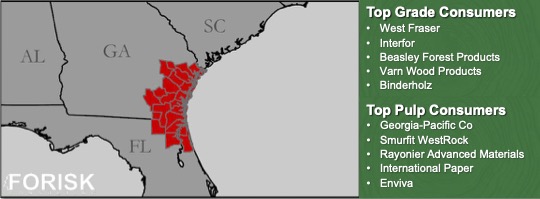When localizing forest supplies, mill capacities, forest operations, and pricing, each timber market produces a unique profile. This uniqueness highlights how timberland valuations, wood procurement strategies, and forest management plans get customized to optimize the market and company assets.
Recently, Forisk launched the Custom Market Forecast (CMF), which includes a dashboard-style report and data file with price (cost) forecasts for client-specific timber markets and wood baskets. The CMF includes other strategic metrics such forest supplies, growth-to-drain, and annualized growth rates, as well as the top five grade and pulp consumers in the market. For example, we recently analyzed a Southeast Georgia market, which included the following map and consumers by product (Figure).
Top Grade and Pulpwood Consumers for SE Georgia Custom Market (Forisk)

Why is tracking wood markets at the firm level helpful? For timberland investors, owning or acquiring private timberland profitably relies on fundamental assumptions, including the desire for deep and increasing demand for logs in local markets populated with multiple firms. This is “good” because it offers competitive conditions for higher timber prices and, ultimately, better investment returns. Alternately, for grade-using mills, wood baskets with stable competition, possibly concentrated in fewer firms, implies less potential upward pressure on log prices over time.
Our research and client experience support these implications. We find that timberland investors prefer and benefit from situations where no two firms combined account for 50% or more of the wood demand for grade. Alternately, grade consumers prefer situations that have fewer competitors. In sum, market concentration speaks to different risks for timberland owners and wood consumers. Therefore, it helps to track the aggregate demand at the firm level over time.

It would be nice to know who is going to benefit the most from all the timber damaged in the southern states from the recent storms? Who were the biggest losers?